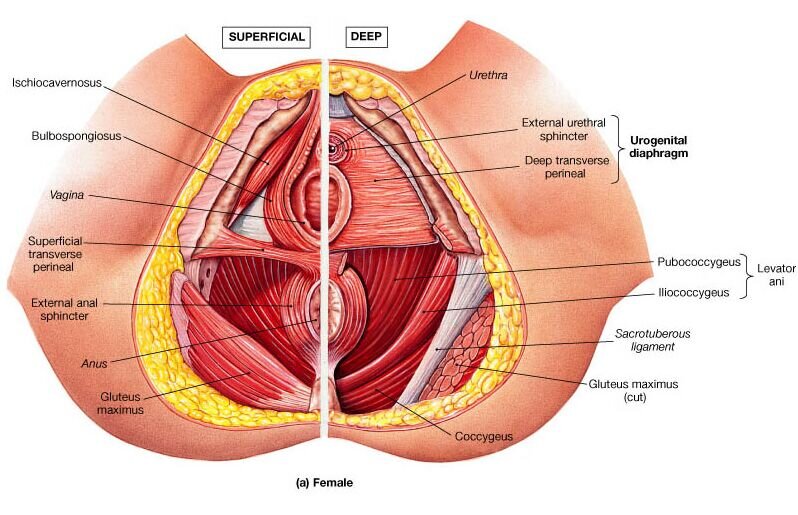Hypertonic Pelvic Floor Dysfunction and Vaginismus
What is hypertonic pelvic floor dysfunction?
Hypertonic pelvic floor dysfunction refers to a condition where the muscles in the pelvic floor are too tight / short. The cause is not always clear and may include the following: chronic straining, poor postures in the sitting, standing, or toileting positions,dysfunctional gait patterns, previous sexual or physical abuse, harmful repetitive movements, childbirth injuries, infection, a traumatic event, cancer-related treatments, abdominal or pelvic surgery, autoimmune disorders and inflammatory conditions. (1) Many women with vulvodynia also have pelvic floor dysfunction, and this is thought to be because of a habit of contracting the pelvic floor in response to pain. Contracting the muscles for a long time decreases blood flow, shortens muscles, and limits mobility; this can lead to the development of trigger points, or knots, in the muscles, which are especially painful.
What are the symptoms of pelvic floor dysfunction?
Tension in the pelvic floor can lead to a variety of symptoms including:
constipation
urinary retention and/or frequency
painful urination or defecation
vulvar burning and/or vaginal burning
dyspareunia (pain with sex)
clitoral pain
lower back pain
hip and thigh pain
It is important to note that hypertonic pelvic floor dysfunction can be a cause of vestibulodynia. In these cases, pain is limited to or most intense at the posterior vestibule (6 o’clock).
What is vaginismus?
Vaginismus is another cause of pain with sex that is associated with the function of the pelvic floor muscles. In women with vaginismus, the pelvic floor muscles contract in anticipation of touch or penetration. This can make penetration painful or even impossible. Vaginismus is unique from other pelvic floor dysfunction in that psychosocial factors play a significant role. You can read more about vaginismus at https://vaginismus.com/.
How are pelvic floor conditions treated?
Pelvic floor physical therapy is the best medical treatment for these conditions. A pelvic floor physical therapist will work with the patient to relieve tension in the pelvic floor muscles using a variety of treatments.
For vaginismus, cognitive behavioral therapy is often required to treat the psychosocial aspects of the condition. Also, a vaginal dilator program is typically used to facilitate penetration with progressively larger dilators.
There are also a few medications used to treat hypertonic pelvic floor muscles. Muscle relaxers like diazepam (valium) or baclofen, typically given as a vaginal or anal suppository, are often used. Botox injections are also becoming more common as research is ongoing. There is a clinical trial in progress testing the efficacy of botox injections in women with vestibulodynia caused by hypertonic pelvic floor dysfunction. Check it out - you might be a candidate. You could get free treatment AND help advance science!
I was incorrectly diagnosed with vaginismus for about a year and a half. I was doing the dilator exercises and trying my best to try to learn to control my pelvic floor muscles. But, since I actually have vestibulodynia and severe pelvic floor dysfunction, no amount of “trying to relax” was going to make my pain go away. I was probably making my psychological trauma worse by forcing myself through painful exercises for months. You can read more about my journey to diagnosis on the About Me page.
I have severe pelvic floor dysfunction. The resting state of my pelvic floor is very tense and I have to focus on letting it come down to get it even close to a normal resting state. I’ve been in pelvic floor physical therapy since January 2018. What I didn’t realize before my diagnosis, is that a lot of my other “mild” symptoms are likely related to my pelvic floor dysfunction. I mostly ignored my low back pain, hip and leg pain, urinary retention and frequency, and constipation. All of these are symptoms of hypertonic pelvic floor dysfunction! I plan to write blogs with more of my story and dealing with pelvic floor dysfunction.
Reference
Irwin Goldstein, Anita H. Clayton, Andrew T. Goldstein, Noel N. Kim, and Sheryl A. Kingsberg. 2018. Textbook of Female Sexual Function and Dysfunction, Diagnosis and Treatment. John Wiley & Sons Ltd., Hoboken, NJ. https://onlinelibrary.wiley.com/doi/book/10.1002/9781119266136

